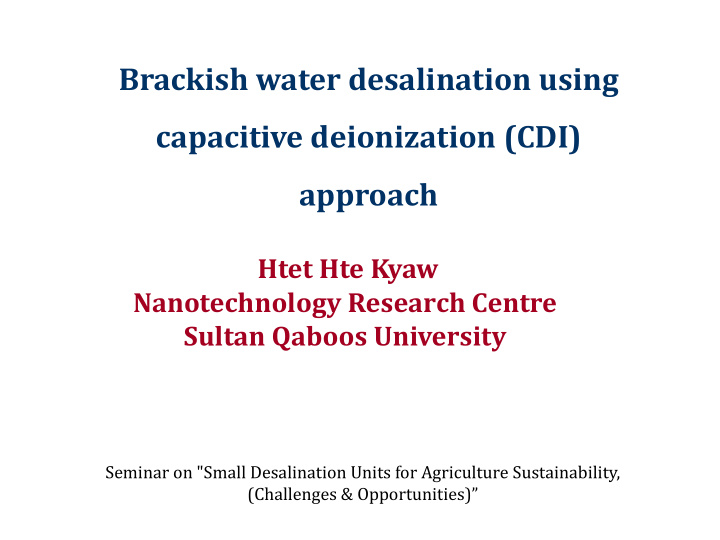



Brackish water desalination using capacitive deionization (CDI) approach Htet Hte Kyaw Nanotechnology Research Centre Sultan Qaboos University Seminar on "Small Desalination Units for Agriculture Sustainability, (Challenges & Opportunities)”
Capacitor Conducting plate (Al foil) Electric double layer Electrodes + + - - Q + Q - + - + - - - + + - - + + - - + + - - + + - - + + - - + + Dielectric + - A typical capacitor Dielectric
Desalination Desalination grew from 3% of total water supply in 1999 to 13% in 2008 RO desalination is the main desalination technology used
Energy Consumption Energy RO CDI Requirement Electrical 2 < 1 (kWh/m 3 ) Acceptable salinity level for Main advantages of CDI technology different applications CDI exhibit less fouling Irrigation & industrial cooling system – No electrode deterioration 1000 to 3000 ppm No pressure required Less energy Household use – up to 1000 ppm Safe drinking water – less than 150 ppm Some limitations Industrial level (high end product) – less § Only ions can be removed than 5 ppm § High energy consumption for high salinity water
Sea Water Intrusion After pumping by many wells Well pumping Cone of Well pumping salty water depression fresh water Ocean Fresh Sea water groundwater intrusion Salt water 65% of fresh water (ground water) available in Oman Increased demand combined with falling water tables lead to rapid seawater intrusion.
Sea Water Intrusion Al Batinah region accounts for >50% of Oman’s agriculture Rapid population growth & increased agricultural activities Salinity increased due to sea water intrusion 2,000 km of coastline (Oman Salinity Strategy. In Ministry Of Agriculture And Fisheries: Sultanate of Oman, 2012)
Capacitive Deionization Electrochemical controlled technique to remove ions by applied potential 0.25 Desalination process conductivity (mS/cm) 0.20 0.15 0.10 Electrode 0.05 0 200 400 600 800 1000 1200 time (s) Saline water + + + + + + + + + + - - - - - - - - - - Electrode Anion (Cl - ) Cation (Na + ) Electrosorption process Higher surface area Higher ions adsorption
Capacitive Deionization 0.30 Regeneration process 0.25 conductivity (mS/cm) 0.20 0.15 0.10 Electrode 0.05 1400 1600 1800 2000 2200 2400 2600 2800 3000 time (s) Brine solution (Out) + + + + + + + + + + - - - - - - - - - - + + + + + + + + + + - - - - - - - - - - Electrode Anion Cation Electrosorption process Higher surface area Higher ions adsorption
CDI cell structure FM-100 ACC Zorflex Current collector Inlet Acrylic plate Activated carbon cloth Spacer Activated carbon cloth Acrylic plate Outlet Current collector 100 m Specific surface area – 1043 m 2 /g pore volume – 1.417 cm 3 /g Mean pore diameter – 0.7 nm & total pore volume – 1.417 cm 3 /g
Results Effect of salt concentration on desalination by synthetic water ► Synthetic Brackish water – 1, 3 and 5 g/l ► Desalination cycle – 17 min ► Feed water salinity increased Desalination efficiency decreased ► Rate of salt adsorption increased
Results Synthetic water Vs Brackish water (from a well in Al Musanaah) Sample Desalination Power Electrode salt efficiency (%) consumption adsorption capacity (kWh/m 3 ) (mg/g) Synthetic water 32 0.85 10.5 mg/g Well water 27 0.75 8.9 mg/g
Results Ion Selectivity Divalent species like Ca 2+ preferentially adsorb over the monovalent species Higher K + removal efficiency due to lower concentration in well water
Results Disinfection properties Bacterial electroadsorption on ACC surface Electrode surface creates a hypertonic environment Dehydration of cells lead to cell death 3-fold reduction in bacterial colonies after desalination Electroadsorption is dominant mechanism of disinfection K. Luxman et al., Desalination 362 (2015) 126-132
Results Long term desalination and electrode regeneration Desalination trends over a period of 1 day for brackish water and synthetic water of similar conductivity 0.01 M citric acid (pH 2.96) followed by 0.01 M NaOH cleaning after 24 hours of operation 14
Conclusions Brackish water was successfully treated using CDI Brackish water power consumption was marginally lower (0.78 kWh/m 3 ) compared to synthetic water (0.85 kWh/m 3 ) Disinfection properties mainly attributed to electroadsorption of microbes Scale forming ions (Ca 2+ ) is efficiently removed during the process Electrodes were completely regenerated after cleaning leading to repeatable desalting capabilities 15
Acknowledgements Nanotechnology Research Centre The Research Council of Oman (TRC) Sultan Qaboos University 16
CDI prototype 17
Recommend
More recommend